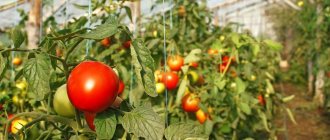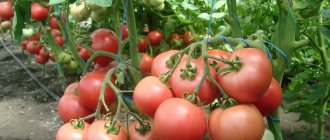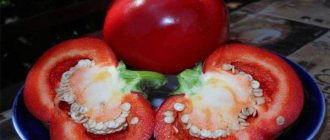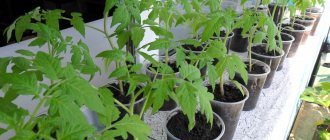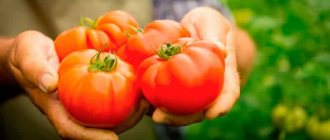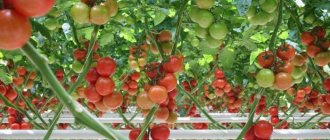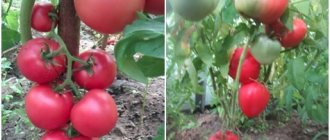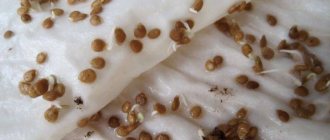Characteristics and description of the variety
The originator of the Spasskaya Tower tomato is the Chelyabinsk breeding station. Vegetable seeds are sold by a large agricultural company under the Ural Summer Resident brand.
The bush is semi-determinate, height up to 1 m, in a greenhouse it grows up to 1.5 m. The stem is strong, the leaves are bright green, medium in size. Up to 10 fruiting clusters are formed on one plant, each cluster bearing 4-6 fruits.
An early ripening hybrid, 95-110 days pass from the moment of germination to full maturity. Increased resistance to changes in weather conditions is observed.
Main characteristics:
- It is highly resistant to diseases of the nightshade family: cladosporiosis, fusarium. Recommended for cultivation in open ground and in greenhouse conditions;
- the yield is high, from 1 sq. m you can get up to 25 kg of fruit;
- the culture requires mandatory gartering and pinching;
- the fruits are large, weight up to 0.5 kg, round shape, bright red color, thick skin;
- Universal use in cooking: suitable for both fresh consumption and canning, pickling, marinades. Used to prepare ketchups, sauces, adjika, lecho;
- subject to long-term storage and long-distance transportation. These factors make the variety profitable to grow for sales.
The photo shows tomatoes Spasskaya Tower f1.
Nuances of agricultural technology for a medium-sized variety
Particular attention should be paid to preparing the soil and the place for planting Spasskaya Tower tomatoes. According to gardeners, it is more convenient to divide the preparatory work before planting the Spasskaya Tower tomato into 2 stages. The variety is demanding on soil fertility, so without adding organic matter it will not be possible to get a good harvest. Compost, humus or peat are added to the soil during autumn digging. At the same time, phosphorus and potassium fertilizers are applied so that by the time the tomato seedlings are planted, they dissolve in the soil.
The second stage of soil preparation occurs in early spring. At this time, nitrogen fertilizers are applied for the growth of green mass.
If the autumn stage was missed, then it is postponed to the spring. The main thing is to complete it a month before the scheduled time for planting tomato seedlings.
In their reviews, vegetable growers note that the Spasskaya Tower tomato variety responds well to the ecological type of fertilizing the soil with green manure. Mustard or rye are suitable for nightshades.
How to grow seedlings
Sowing of seeds begins 2 months before planting seedlings in open ground.
The soil mixture is prepared from peat, humus and garden soil in equal proportions. For 1 bucket of the mixture add 1 teaspoon of superphosphate, potassium sulfate and urea. The prepared soil is disinfected with boiling water, poured into planting containers and moistened 1 day before sowing.
You can plant both in a common container and in individual containers. For the convenience of subsequent replanting into the ground, peat pots are used. They are convenient because there is no need to replant the seedlings from them; they are buried in the beds along with the sprouts. Subsequently, the peat pots dissolve in the ground without causing harm to the root system.
Preparing seeds before sowing is as follows:
- Soaking in a solution of liquid fertilizer, for example, Agricola-Vegata, for 1 day at an air temperature of 25 C. Before placing the grains in the solution, they are wrapped in gauze or cloth.
- Hardening the grains for 2 days in the refrigerator, after soaking in the solution. The container with the swollen grains is wrapped in cellophane and left in the refrigerator on the bottom shelf. This will make them strong, which will help in further full growth and development.
Seeds are planted in prepared soil to a depth of 1 cm with a distance of 2 cm between them. The distance between the rows is at least 5 cm. After sowing, the soil is leveled from above and the containers are covered with film or glass. The room where planting containers are left must be bright and warm, the air temperature is at least 24 C.
When shoots appear, the film is removed. Seedlings need full lighting. If there is not enough daylight, they are illuminated with ordinary lamps. At the same time, the temperature in the room is reduced to 18 C, and the sprouts remain at this temperature for 5 days. Then the temperature is increased to 23 C.
When two true leaves appear, the seedlings dive and are planted in separate containers.
The photo shows the picking of seedlings:
Water the seedlings as the top layer of soil dries out. The sprouts are not filled with water, but with a teaspoon, the warm, settled water is carefully distributed along the edges of the nursery.
After watering, the soil must be loosened with a regular fork or wooden stick.
After a month, the seedlings are transplanted into a larger container for the full development of the root system.
2 weeks before planting seedlings in open ground, they begin to harden them. The hardening procedure boils down to leaving the bushes outside for 2 to 3 hours. At night, in the room where the seedlings are located, the temperature is reduced to 13 C. The time spent outside gradually increases to 18 hours.
Features of cultivation
Tomatoes of this hybrid will produce a large harvest of high-quality fruits only if all points of the technology are followed, including the following work:
- proper preparation of the substrate for seedlings and the area for planting;
- preparing seeds for sowing;
- sowing seeds;
- timely and correct planting of seedlings;
- high-quality care for planted tomatoes.
Preparation of substrate for growing seedlings
The soil for seedlings should be prepared in the fall. The following are taken as components:
- turf land;
- compost or humus;
- river sand.
The first 2 components are taken in equal parts and 5-10% sand is added to this mass.
Attention! It is unacceptable to use garden soil on which peppers, potatoes, and tomatoes grew as a component of the substrate for tomato seedlings. It is better to take the soil after growing cabbage.
To disinfect small volumes of the substrate, it is disinfected:
- roasting in the oven;
- freezing outside.
Ready-made soil mixture can be purchased at a specialty store.
Sowing seeds
- The day before sowing the seeds, fill the seedling boxes with substrate and moisten it.
- Tomato seeds that have gone through the preparation stages - soaking, hardening - are sown in boxes before March 15.
- Seed grooves are made in the boxes with a depth of 8 mm, tomato seeds are laid out on their bottom at intervals of 1-2 cm. The distance between the grooves is 2 cm. The seeds are sprinkled with a small layer of soil and compacted with the palms.
- Seedling boxes covered with film are kept until germination at a temperature of +25 degrees.
- With the emergence of starting shoots, the film is removed, the boxes are transferred to a bright room with a temperature of +12 degrees for a week. Under such conditions, the seedlings will not stretch.
- After a week, the temperature is raised to 20-22 degrees Celsius.
- When the seedlings are 12 days old, they are planted into pots or cups, giving the plants more living space.
Subsequent care of seedlings includes:
- watering;
- temperature control;
- feeding;
- hardening - carried out a week before planting.
In May, 60-day-old plants are planted in garden beds.
Important! For planting, you should not use seeds collected yourself. Hybrid seeds do not retain the best qualities of the parent tomatoes. Therefore, one cannot expect a high-quality and abundant harvest from such crops.
Transplanting
For planting, 60-day-old seedlings with 5-6 true leaves, a healthy appearance, and a strong stem are used. Planting is carried out on a pre-prepared area, in planting holes located according to a 40 by 50 cm pattern.
Immediately after planting, the tomatoes are watered generously. After 3-4 days, the established seedlings are attached to the supports.
Proper tomato care
Activities for caring for tomatoes of this hybrid in the garden include:
- weekly abundant watering;
- three times feeding per season;
- monthly weeding of the beds, loosening the soil after each watering;
- tying grown seedlings to supports;
- removal of stepsons, yellowing and shading leaves;
- pest and disease control.
Important! All feeding of tomatoes is planned only after watering or precipitation.
How to care for tomato bushes in a greenhouse
In greenhouses, tomatoes have more comfortable conditions, so the fruit yield is higher. But there, tomatoes often suffer from excessive air humidity, which causes the development of harmful fungal microflora. Therefore, in protected soil, you can water tomatoes only at the root.
Several techniques are used to reduce the relative humidity in the greenhouse:
- use of drip irrigation;
- mulching the soil with sawdust and grass;
- opening the windows to ventilate the room;
- control of the density of tomato bushes.
Important! In the greenhouse, this variety is distinguished by larger fruits and their simultaneous filling on the clusters. To protect the stem from overload, it is mandatory to tie the plants to the trellises.
Pests and diseases
The hybrid Spasskaya Tower requires preventive protection against fungal infection. In wet years it can be affected by late blight. To prevent the spread of the disease, prophylactic treatment with phytosporin or any other antifungal drug is recommended.
If you adhere to the requirements of crop rotation and liming of acidic soils, a massive invasion of harmful insects does not occur. Sometimes slugs crawl into the greenhouse; at the beginning of spring, Colorado potato beetles can eat tomato leaves. Single pests can be collected by hand and destroyed.
How to grow tomatoes
After 2 months, the seedlings are ready to be transplanted to a permanent location.
Beds for tomatoes are chosen in a sunny place protected from drafts. Planting pattern: 50 cm – distance between seedlings, 50 cm – between rows. For 1 sq. m place no more than 4 seedlings.
Plant the tomato in pre-prepared holes, 15 cm deep, in a checkerboard pattern. This method of planting provides additional advantages: the plants not only do not interfere with each other’s growth, but also receive enough light and are well ventilated. Seedlings will take root faster in a new place if they are transplanted on a cloudy day or in the evening.
Before planting, add a humate solution to the holes and pour 1 liter of water into each hole . It is not advisable to apply fresh manure to tomatoes, as it promotes the development of green mass, while the fruits are small due to insufficient nutrients.
After planting, the bushes are watered moderately with warm, settled water, strictly at the root. Afterwards the soil is loosened, hilled and mulched. Loosening promotes better penetration of oxygen to the roots, and mulching retains moisture in the beds longer.
Reference ! In order for the seedlings to take root in open ground faster, they are covered with non-woven material.
The next watering is a week later, with water previously heated in the sun. Further watering - as the soil dries, but not more than twice a week. The culture responds well to drip irrigation. In hot weather, the frequency of watering is increased to four per week. Also, water more often when the fruits are pouring.
The first feeding is carried out when the tomatoes on the lower branch reach the size of a nut. Feed with complete mineral fertilizer with a complex of microelements (35 g per 1 bucket of water) or organic matter.
, diluted in a ratio of 1 kg per 1 bucket of water, are suitable as organic matter From this period, 10 g of potassium sulfate is added to each feeding. Further fertilizing is carried out once every 14 days with the same solution, adding 1 teaspoon of humate per bucket.
Due to the high growth, plant staking is required. Moreover, not only the stem, but also the fruiting clusters are tied up, otherwise they will not withstand the weight of ripe vegetables.
For a high fruiting rate, the Spasskaya Tower tomato needs proper pinching. This procedure is carried out regularly; only one shoot is left under the first flower cluster, since the plant is led into 2 trunks. It is necessary to brush once a week.
Diseases and pests
Tomato crops are rarely attacked by insects and various infections. The only danger is late blight, a fungal disease that can be prevented by controlling moisture in the beds. Over-watered beds promote rotting of the lower leaves of plants, which creates a favorable environment for any fungal disease.
Experienced gardeners immediately after transplanting seedlings spray them with copper oxychloride (30 g per 10 liters of water), which not only helps in growth and development, but also increases the immunity of seedlings.
To treat late blight, systemic fungicides are used, for example, the drug “Hom” or “Fitosporin”. If the disease is at an early stage, copper sulfate will help, which is also suitable as a preventive measure.
Of the parasitic insects, whiteflies and spider mites can cause harm. Spider mites live in greenhouses. To destroy it, it is enough to ventilate closed structures every day. This will destroy the pest’s usual habitat.
The whitefly butterfly harms plants in open beds. Strong-smelling herbs such as marigold and calendula will help combat it. Onion and garlic arrows also help well. Plants can be sprayed with a decoction of onion peels without harming the developing fruits.
Pest and disease control
Pests rarely attack Spasskaya Tower tomatoes. Spider mites may appear in the greenhouse. It forms pinholes on the leaves, causing them to dry out. They fight it with an infusion of garlic peels: per 1 liter - 200 g. After a day, the plants can be sprayed.
Advice! This remedy also helps against late blight.
Among insectoacaricides, you can use Fitoverm - this biological preparation works well and is not dangerous for humans.
Whiteflies are controlled with the help of Cytkor or Fosbecid.
Since tomatoes of the hybrid variety Spasskaya Tower are resistant to many diseases, special attention should only be paid to the fight against late blight, to which they are not resistant. Preventive and therapeutic treatments with biological preparations Fitosporin, Gamair, Alirin B. help well.
They must be carried out according to the instructions.
The nuances of growing in open ground and in a greenhouse
The variety is recommended for cultivation in open ground and in greenhouse conditions.
Subject to the rules of agricultural technology and crop rotation, the harvest is obtained within six months in open ground, and in greenhouses - all year round. Due to high adaptation to weather vagaries, sudden frosts do not affect the quantitative indicator of fruiting.
The unusual structure of the bush helps the plant to fully grow and develop. Half of the nodes do not form stepsons, thanks to which the tomato receives a sufficient amount of light and is regularly ventilated.
In open ground, proper crop staking . Very young bushes begin to be tied up two weeks after transplantation. This allows the stem to form even and strong. Branch garter is also necessary.
In a greenhouse, the height of seedlings is greater than in open ground. This means that there are more fruiting clusters on them, which increases the number of ripe vegetables.
Regular ventilation of the greenhouse will help keep the plants healthy all year round. But do not forget that the tomato is afraid of drafts.
Brief information about the variety
- Fruits and bush : determinate bush, fruits up to 500 g.
- Productivity : 30 kg/m².
- Resistance : frost-resistant, can grow in the shade, resistant to diseases and pests.
- Distribution : all of Russia, but intended for Siberia, the Urals.
- Application : fresh, juices, tomato pastes, salads.
- Planting : seedling method, in a checkerboard pattern 40x50.
- Soil : neutral acidity.
- Care : watering - twice a week. Pinch the top shoot and tie it to a peg during planting.
- Ripening period : 1-3 months from the moment of planting seedlings, can bear fruit for six months continuously.
- Shelf life : fresh harvest can last about 30 days.
Harvesting and application
Thanks to the garter, picking ripe vegetables is not difficult. Ripening is amicable, with whole clusters. The first vegetables ripen in July.
A record amount of ripe vegetables can only be obtained in a greenhouse, here from 1 sq. m harvest up to 25-30 kg.
The use of tomato is universal. It is equally good for fresh consumption and canning. It makes excellent summer salads, hot dishes and vegetable dishes. Does not lose its taste in marinades and pickles. Used for preparing tomato products: lecho, paste, juice, adjika, sauces, ketchup.
Can be stored for a long time and can withstand long-term transportation. The variety is widely used for commercial purposes, as it perfectly preserves its appearance without losing its taste.
Characteristics of the Spasskaya Tower tomato
The characteristics of this new hybrid are impressive:
- highest productivity;
- excellent taste of beautiful and large fruits;
- good transportability;
- cluster fruiting;
- quite early ripening period for a greenhouse hybrid;
- determinant growth method;
- average bush size;
- caring for the Spasskaya Tower is simple;
- good resistance of the hybrid to most diseases;
- adaptability to unfavorable growing conditions.
Productivity and fruiting
The originators of the tomato hybrid Spasskaya Tower f1 claim yield per 1 sq. m up to 30 kg, which is confirmed by reviews from gardeners: tomatoes stubbornly set and fill, despite unfavorable weather conditions.
Each bush is capable of producing a harvest of up to 8 kg in about 100 days, and per 1 sq. There are 4 of them. But this is only possible if all agricultural techniques are followed. What affects productivity:
- the method of growing the hybrid is a greenhouse or open ground, in the latter case the harvest will not be record-breaking;
- performing all tomato care operations on time and in full;
- weather.
Area of application of fruits
Since Spasskaya Tower tomatoes, according to gardeners, have a good taste, their use is universal. They are also good in summer salads, one such tomato is enough for the whole family, and in marinade or pickling. Tomato paste also turns out excellent, since the dry matter content in the fruits of the hybrid is high.
Resistance to diseases and pests
When creating this hybrid, breeders paid special attention to disease resistance. And they were successful. The Spasskaya Tower does not care about TMV - tomato mosaic virus, fusarium, cladosporiosis, root-knot nematodes. Only routine protection against late blight will be required, but this is done for all varieties and hybrids of tomatoes.
Advantages and disadvantages of the variety
There are much more of the former than the latter:
- early ripening;
- amazing productivity;
- excellent taste and appearance of the fruit;
- resistance to both diseases and the vagaries of the weather;
- cluster fruiting;
- universal use;
- unpretentiousness and ease of cultivation;
- determinant type of growth.
The disadvantages of a hybrid variety include a weak root system, which will require high-quality garter, and the inability to collect seeds for sowing next year: hybrids do not repeat maternal characteristics, all advantages will be lost.
Advantages and disadvantages
The hybrid has a lot of advantages that make it increasingly popular among vegetable growers:
- high adaptation to climatic conditions;
- early ripening variety;
- high fruiting rate;
- ease of care;
- disease resistance;
- survival rate in all regions;
- possibility of year-round breeding in a greenhouse;
- excellent taste of ripe vegetables;
- marketable condition;
- long storage;
- long transportation;
- Possibility of use for commercial purposes.
Some disadvantages of this type:
- poor development of the root system;
- regular stepsoning is required;
- Garter required;
- inability to independently prepare seed material.
Growing tomatoes
The characteristic indicates that the place for growing tomatoes should be chosen in the fall.
It is necessary to immediately fertilize the soil with compost, humus and peat. This will help nourish it with all the useful elements for spring. After fertilizing, the area is dug well.
Nitrogen fertilizers are applied in the spring. If the moment of autumn fertilizing was missed, then it is allowed to fertilize in the spring, on the eve of planting, a month before planting the seedlings (in this case, nitrogen is not added).
The tomato requires pruning of excess shoots to avoid branches breaking off. It is possible to plant 3-4 bushes per 1 m².
Favorable soil for planting is the one on which cucumbers, onions or cabbage previously grew. These vegetables themselves are a fertilizer, after which useful substances remain in the soil.
The Spasskaya Tower variety is called unique because it does not need a lot of light and feels great in the shade.
Planting seeds
Seeds are prepared for planting.
Seed preparation begins 2 months before planting (March-April). The most favorable soil is with a neutral pH reaction.
The following activities need to be carried out:
- soak in 1% manganese solution;
- leave Agricol or Effecton in the solution for 1 hour;
- leave in the refrigerator for 48 hours.
Humus and garden soil are added to the soil (1:1). Add 1 tsp. superphosphate, 1 tsp. potassium sulfate, then pour over boiling water and place in the oven for disinfection for half an hour.
Seeds are sown to a depth of 1 cm and at a distance of 2 cm from each other.
Rules for growing seedlings:
- the temperature in the room should not be lower than 18°, optimal – above 22°C;
- Humidity should be maintained at 75%;
- daylight hours 12 hours;
- organic and mineral fertilizers are needed 1-2 times;
- after 2 true leaves appear, the plant is planted in a separate container.
The seedlings will be ready for planting in a permanent place when 5-6 leaves appear, and the stem is strong and 15-20 cm high. Before planting, it needs to be hardened off; to do this, take it out to the balcony every day. Starting from 1 hour, each time increasing the amount of time.
Transplantation into soil and greenhouse
The size of the plant to be planted should be no more than 20 cm. Otherwise, it will be very difficult for it to take root. You can plant in open ground as early as May.
():
Large seedlings (30 cm or more in height) take root less well. Do not overcook seedlings or sow seeds too early. The optimal height of tomato plants is 15-20 cm.
Before planting, plants are sprayed with a solution of copper oxychloride (30 g per bucket of water). You need to plant in a checkerboard pattern, 40x50.
Description of the landing sequence:
- clear the soil of weeds, dig up;
- make small holes on the bayonet of the shovel;
- pour 0.5-1 liters of water into the holes;
- lower the seedlings into the holes and compact the soil;
- Hill up the seedlings or mulch the soil.
In greenhouse conditions, the planting rules are exactly the same. Only here you need to monitor the temperature. The temperature in the greenhouse should not exceed 30°C, ventilate regularly.
You can temporarily tie the seedlings to a stake or trellis to prevent them from falling.
Farmer reviews
A review of reviews of the Spasskaya Tower tomato speaks of the high quality of the hybrid.
Marina, Moscow region:
“The hybrid is wonderful. It does not require a lot of time and effort, and the return is incredible. Vegetables are tasty, store well, and are suitable for any type of dishes and preparations. The yield is stable."
Valery, Rostov region:
“I’ve been growing tomatoes in an industrial greenhouse for two years now. I'm pleased with the result. The plants are tall but well ventilated. I mechanize the collection of vegetables, they do not crack and are easily transported.”
Planting seedlings and caring for plants
Planting scheme for a 40x50 cm variety. As soon as the seedlings take root, they are tied to supports. Form bushes into 2 stems, promptly removing excess shoots. In addition to these actions, according to the description of the variety and reviews of the Spasskaya Tower tomato, an important role is played by:
- Watering. The hybrid does not require a large amount of water, but the watering rules remain standard - in the evening or in the morning, at the root and with warm water. The ideal option would be to organize drip irrigation. But if this is not possible, then the hybrid must be provided with water once a week.
- Feeding. For tomatoes of this variety, alternating organic and mineral fertilizers are used. The first time nutrition is applied 2 weeks after planting the seedlings. As soon as the ovaries begin to actively form, potassium is needed as part of complex mineral fertilizers. During the fruiting period, repeat the application of potassium, slightly increasing the dose.
- Pinching allows you to preserve the vitality of the tomato to feed the fruit, and not the green mass. The fruiting period increases, and the tomatoes grow larger. Stepchildren are removed at least once a week.
- Ventilation. This event is simply necessary when growing tomatoes in a greenhouse. High-quality ventilation prevents the development and spread of diseases.
- Tying. Use one of the options. The first is tying the bush to a separate support. The second one is more suitable for greenhouses; it is tied to common trellises.
Reviews about the variety from those who planted
"Spasskaya Tower" F1 is a wonderful hybrid. This variety has many fans who praise the bushes for their unpretentiousness. Also, many people like the large fruit and excellent taste of tomatoes.
Even the lazy gardener will really like the hybrid variety “Spasskaya Tower” F1, because it adapts to any climate, even harsh ones, and the bushes of these tomatoes do not require any special growing skills and do not require complex care.
The best tomato varieties for the Urals and Siberia:
Watering
A special feature of tall tomatoes is that they should be watered directly at the root with the amount of 1 liter or more per plant. It is important that the water does not wet the leaves. On cloudy days, it is enough to water twice a week, and more often in hot summers.
The best water for this will be settled water, heated in the sun to a temperature of at least 24... 26 degrees. If for some reason the water stands still or is absorbed very slowly, experienced gardeners advise making several punctures in the ground around the roots.
It is better to lightly loosen the soil immediately after watering, but only superficially, so as not to damage the root system. In the fall, when the last fruits are already ripening, the stems need to be untied from the supports and carefully laid along the bed. There is no need to water the plant during this period.
Positive qualities of the variety
Hybrid tomatoes are endowed with a number of tangible advantages. The main advantages are reflected in the table.
Advantages of the tomato hybrid Spasskaya Tower
| Fruit ripening period | The fruits ripen in 95-115 days from the date of initial shoots. During this period, other vegetables are suitable, which allows you to diversify the diet and the list of preparations. |
| Versatility of cultivation | This variety of tomatoes is suitable for growing in gardens and greenhouse conditions. The main varietal properties do not depend on the place of cultivation. |
| Saving space | The height of the plants reaches 150 cm, and 40 juicy fruits are formed on each bush. Even a few planted bushes in the garden provide the family's needs. |
| High yield | If you strictly adhere to technological requirements, fruiting lasts 180 days. 30 kg of fruit or more is collected from each m². |
| Resistance to changes in weather and unfavorable growing conditions | The onset of cold weather, a sharp drop in temperature and a lack of light do not reduce the yield of this determinate variety. |
| Resistance to common diseases | This variety is not susceptible to infection by fusarium, cladosporiosis, nematode, or viral infections. Stepchildren do not form from half of the leaf axils, so the bush is evenly illuminated, well ventilated, and is in optimal conditions. |
| Excellent fruit taste, usefulness | With proper care, almost 50% of tomato fruits reach a weight of 500 g. The fruits are tasty, contain many useful substances, withstand transportation well, and are stored well. |
| Versatility in use | The fruits of the hybrid can be eaten fresh or used for preparing preparations. |
| Ease of care | The tomato is not tall and produces few shoots. Thanks to this, it is easy to pick fruits from the bushes; it does not require a lot of time for pinching. |
Experts highlight some disadvantages of the hybrid:
- the plant has an insufficiently strong root system and requires garter;
- the procurement of seed material from grown fruits is excluded.
Apple tree Zvezdochka: description, photos, reviews
